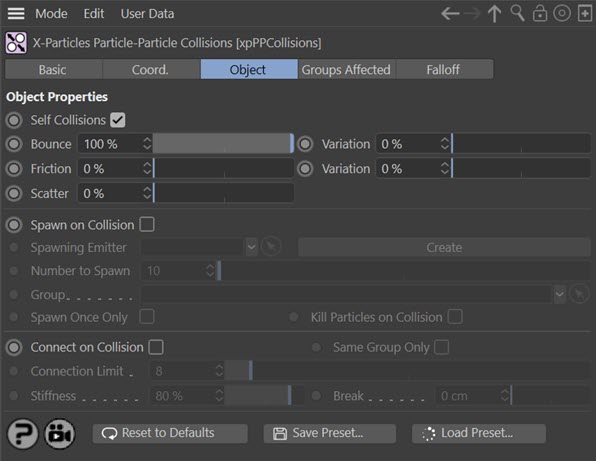Particle-Particle Collisions Object
If you want to see collisions between particles, as opposed to collisions with a scene object, add this object to the scene.
Interface
The object's interface looks like this:

For the 'Groups Affected' and 'Falloff' tabs, and for the buttons at the bottom of the interface, please see the 'Common interface elements' page.
Parameters
Self Collisions
If checked, particles will collide with other particles from the same emitter.
Bounce (and Variation), Friction (and Variation), and Scatter
These settings are identical to the same parameters in the Collider tag. Please refer to the tag for details.
Spawn on Collision
Check this switch to spawn new particles when two particles collide.
Spawning Emitter
Drag an emitter into this field; this emitter will be used to generate the new particles. As explained in the Spawn modifier page, it is NOT a good idea to use the same emitter which is producing the particles which collide and trigger the spawning. Use a different emitter instead. When you drag an emitter into this field, the 'Emitter Only Spawns' switch in that emitter will be turned on automatically. If you really need it turned off, you can do so manually.
Create
Click this button to create a new spawning emitter and add it to the link field.
Number to Spawn
This is the number of particles to be spawned on collision.
Group
This enables you to specify the group to which the spawned particles will belong. If there is nothing in this field, the group is determined by the spawning emitter. To specify the group, drag the desired Group object into this field.
This setting is useful if you want to ensure that the spawned particles are, or are not, affected by a specific modifier, for example.
Spawn Once Only
If this switch is on, the emitter will only spawn once from a collision between two specific particles. After that, neither particle will spawn again unless in collision with another particle which hasn't yet spawned.
Kill Particles on Collision
If this switch is checked, both the colliding particles will be removed from the scene (this doesn't stop you from spawning new particles from the collision).
Connect on Collision
If this switch is checked, when two particles collide a connection will be made between them. You can see these if you turn on 'Display Constraints' in the Display tab of the emitter.
Same Group Only
If this switch is checked, particles will only connect with particles they have collided with if both particles are in the same group.
Connection Limit
This is a limit on the number of connections each particle can make. Too many connections can dramatically slowdown playback in the scene.
Stiffness
This is a measure of how "strong" the connection is.
Break
A measure of how much the connection can stretch before it breaks. The connection will break if its length exceeds the value in this setting. A value of 0 means that the connection will never break.
Notes
To restrict particle-particle collisions to certain particles, simply create however many particle groups are required and drag the particle groups to be affected by the object into the 'Groups' list in the 'Groups Affected' tab.
You should be aware that if you have a large number of particles close together, it may seem as if some particle-particle collisions are being missed. Consider the situation with three particles close together. In a particular frame, particles 1 & 2 collide and particle 2 is given a new direction. It doesn't actually move anywhere yet, the movement of a particle is calculated at the end of the frame when all the influences on a particle, such as modifiers and collisions, have been taken into account. Before then though, suppose a collision between particle 2 and 3 is also detected. Particle 2 then is given a different direction, overwriting the one from the previous collision. Looking at the animation it would seem as though the first collision had been missed and only the second one detected.